► BMW’s new M240i coupe vs rivals
► All-wheel drive super machines thrashed
► Which is the best one?
Powerful, all-wheel drive – yes, even the BMW – and small enough to hustle without fear, the new Audi RS3, M240i and A45 S are fast and huge fun. Which is best?
Pre-flight briefing: BMW M240i
Why is it here?
Even though it’s not a hatchback, the M240i is clearly aimed at precisely the same buyers as the RS3 and A45: keen drivers with disposable income and at most modest family commitments.
The lineage goes back to M versions of the 1-series, which were more obviously high-end hot hatches, whereas this latest iteration is at heart a scaled-down 4-series. BMW insists on calling it a 2-series, even though it has precious little in common with the Gran Coupe and Active Tourer. Although bigger and heavier than the last generation, it has the great combination of stiffer body and more compliant suspension.
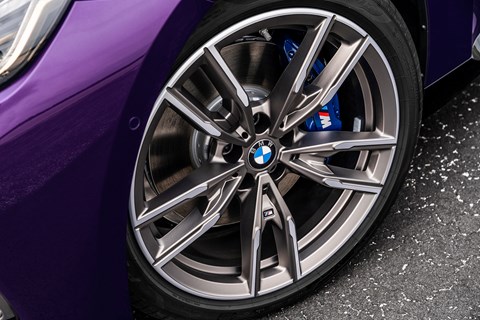
Any clever stuff?
The genius is in the way everything is put together. If, however, we can single out one neat detail, it’s the Sprint function that comes with the Steptronic Sport transmission. The driver simply holds on to the ‘down’ paddle for one second, and the transmission changes into the lowest usable gear, giving a burst of acceleration that’s more useful than Launch Control.
Which version is this?
The M240i xDrive Coupe. It’s the range-topper for the 2-series coupe line-up – the others being the rear-wheel-drive 220i and 220d. The M240i is only available with xDrive (the rear-biased all-wheel-drive system), an eight-speed automatic gearbox and the straight-six engine from the M3/M4, here making 369bhp. Upgraded M Sport brakes are £300 well spent as part of the M Technology pack.
In the UK there’s only one version, fitted as standard with M Sport suspension and variable sport steering, priced from £45,795. An M2 will follow later this year; can it really be a better road car than this?
Read our BMW 2-series coupe review
Pre-flight briefing: Audi RS3 Sportback
Why is it here?
Because over the years the classy, crushingly competent RS3 has established a reputation as being so much more than just a posh VW Golf R. With the latest model, Audi is emphasising the undeniable bloodline between the new cars and the Quattros of road and rally legend, and with good reason.
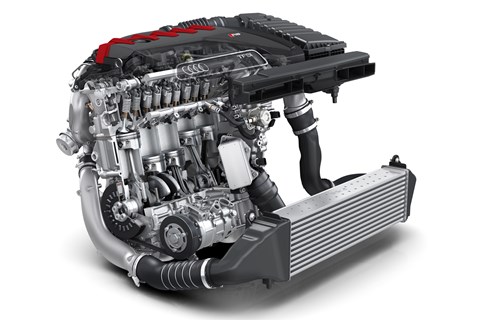
Any clever stuff?
The RS Torque Splitter, examined last month in the Tech section, is a smart way of bringing fully variable torque vectoring to the rear wheels. But ultimately the star of the show is the RS3’s free-revving, high-boost, aluminium-blocked five-cylinder engine, a version of the unit seen in the last RS3 and the current TT RS. Economic sense? Nope, not in the slightest. Great motor? Yes.
Which version is this?
The car you see here is the Launch Edition but that’s no longer available, so the spec and pricing given here are for the current range-topping Vorsprung (now Audi’s standard designation for the top-spec versions of its cars), which starts at £61,655 and comes with adaptive suspension and a top-speed increase (from 155mph to 180mph – how useful), as well as a Bang & Olufsen audio upgrade and more driver-assistance systems. The RS3 is available from £54,405 in entry trim, or £59,055 for Carbon Black.
As well as the Sportback (otherwise known as the five-door hatchback), the RS3 is also available in Saloon (four-door) form, with near-identical performance and pricing that’s £1k extra. And don’t forget the rather tamer (in a 306bhp kind of way) and usefully cheaper (from £40k) S3. The Golf R is also an alternative not tested here, and considerably more affordable.
Read our Audi RS3 review
Pre-flight briefing: Mercedes-AMG A45S
Why is it here?
With the A45, AMG has taken an A-Class hatch and turned it into an object of cult worship by fitting it with the world’s most powerful production four-cylinder turbocharged engine (up 40bhp on the previous model) as part of a no-holds-barred effort to make every rival look tepid. It’s the premium performance hatch benchmark.
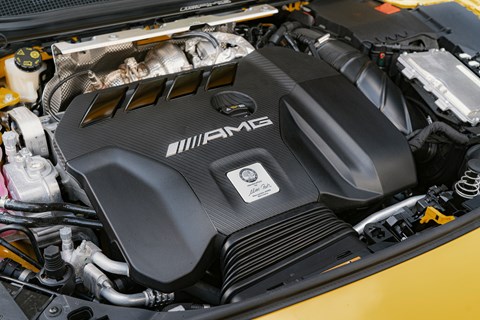
Any clever stuff?
The new rear axle differential uses two multi-plate clutches, each connected to a drive shaft. This means that torque can be precision-metered to the rear wheels separately, as well as being variably distributed between front and rear, for better traction in both adverse conditions and during hard cornering. It also allows Drift mode to be included.
All the front-to-rear and side-to-side torque distribution is electo-mechanical rather than electro-hydraulic, which allows actuation of the clutches to be independent of engine speed and, Mercedes says, gives faster responses.
Which version is this?
Only one A45 S is currently offered, the A45 S 4Matic+; we don’t get the 382bhp non-S in the UK. It’s priced from £57,885, and is equipped as a range-topper in terms of both performance and infotainment tech. There’s not much of substance left on the options list; a bit of Active Distance Assist leaves our test car just shy of £60k.
The CLA 45 is basically an A45 shooting brake, and is only slightly more expensive, although the dog/passengers/shopping in your life may not thank you for getting this as a supposedly sensible choice, as it’s as fidgety and speed-focused as the hatch. There are also less powerful 35 versions of both, which cost less and are more comfortable all-rounders.
Read our Mercedes-AMG A45 review
Catch them if you can: M240i vs RS3 vs A45S
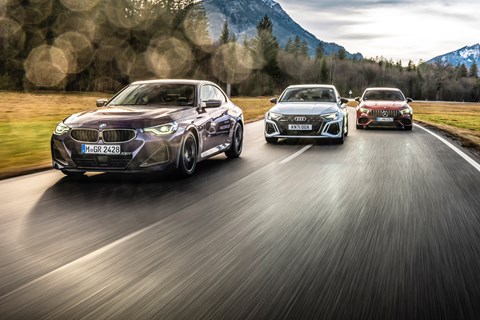
Tell me, do you ever actually stage a pedal-to-the-metal 0-62mph run? It’s a figure quoted all the time, and taken very seriously in certain circles. If you regard it as the hot hatch holy grail, then the test ends here for you: Audi claims a sprint time of 3.8sec for the RS3, the Mercedes-AMG A45 S in its slipstream can do the job in 3.9sec, while the BMW is another four-tenths behind at 4.3sec. Half a second between first and last.
But that dragstrip exercise is in reality only a fragment of the bigger picture. Neither the RS3 nor the A45 feels as quick off the mark as a PDK-equipped Cayman GT4, for instance. The Porsche crosses the line in the same time as the Merc, according to the stopwatch, but the GT4 feels rather more rousing. And when it comes to feel, the M240i xDrive really doesn’t seem half a second slower.
There’s a good reason behind all this. The 2.0-litre four-cylinder AMG engine needs 5000rpm to muster its maximum torque of 369lb ft. The Audi 2.5-litre five-cylinder’s 369lb ft peak is at 2250rpm, while the 3.0-litre straight-six in the BMW requires only 1900rpm to produce an identical force.
It’s not the number of cylinders that matters here. What really counts is the combination of displacement, calibration and gearing. The result is that the BMW can, on public roads, keep up with its rivals – and that’s without even pulling out all the stops.
With this trio of compact all-wheel-drive performance cars – you might want to call them hyper hatches, except one’s not a hatch, and the two that are hatchbacks are both also available in other body styles – you soon realise that there’s a significant gap between on-paper form and real-life observations. It’s not the engine in isolation, or the chassis, or those in-dash bits of tech that tip the scales. More than ever, this threesome is all about the sum of each player’s parts.
These cars all have significant differences, beyond the number of cylinders. In character, content and composition, they are quite distinct. But there’s enough overlap for it to be very clear that they’re aimed at the same type of customer.
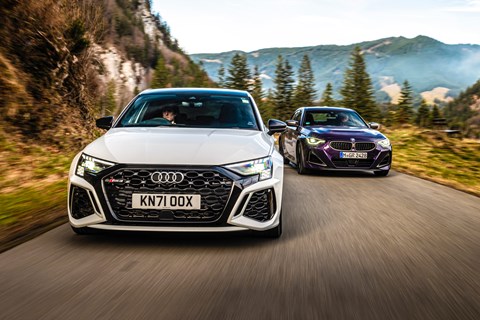
The RS3 Sportback – priced from £54,405 – is the latest and most extreme iteration of Audi’s hot hatch; we drove it in four-door Sportback form in the December issue. Equally new is the BMW M240i xDrive Coupe, priced from £45,795, the hottest version of the current 2-series until the M2 arrives. And they’re up against a car that’s come to define the beyond-hot hatch: the A45 S 4Matic+ (that’s a lot of name, but the only version of the A45 available). Yours for £57,885 – which would be the most expensive entry price, except that our Audi is in top-spec form and blessed with various packs that take it up to £66,655 as tested.
The Audi’s engine is an icon in its own right – a single-turbo 2.5-litre five-cylinder – and it’s a proper powerhouse. It was bench-tested by Audi Sport at up to 550bhp when the old world order was still intact, but even this detuned 394bhp version ticks all the right boxes – as long as the revs are kept on the busy side of 2500rpm. Peak power is delivered at a fairly relaxed 5600rpm. The ceiling for the six-cylinder BMW spans 5500 to 6500rpm. But the AMG four – the smallest engine here, and the hardest working – needs a roaring 6750rpm to muster its full force. Particularly with Dynamic or Race mode engaged, the Merc is all about high revs, accompanied by loud synthesised engine noise and artificial throttle-blipping. Some will hate this pre-programmed hyper-agility, but the AMG approach has a lot of fans – and they’ll lap up the Launch Control setting, which increases the idle speed and opens all exhaust flaps before igniting the crackling take-off fireworks.
Audi’s answer to the Swabian decibel attack is a somewhat more pronounced rear-biased torque split, certainly in terms of feel, more standing-start wheelspin and a slightly shorter ratios for first and second gear. Although the 394bhp RS3 is 20kg heavier than the 416bhp A45 S, the combination of shorter-legged transmission and hungrier all-wheel-drive calibration secures that token one-tenth advantage in the 0-62mph shootout.
BMW used to be an avid supporter of dual-clutch transmissions, and still offers it in some 1- and 2-series models, but the latest M3/M4 has returned to the eight-speed M Steptronic Sport – and that’s what’s fitted to the M240i, underlining its closer connection to the M3/M4 than to the more humdrum members of the 2 family. A super-stiff and fast-acting torque converter like this can relay all the pros and none of the cons of a DCT.

Having said that, both the staccato eight-speed dual-clutch shifter of the Mercedes and the techno-beat seven-speed ‘box fitted to the RS3 turn every single full-throttle upshift into a more physical and more emotional exclamation mark. In the sportiest drive mode, change-up action is whiplash brutal and brusque while the equally sudden hardcore downshifts are liable to make the entire drivetrain shrug and judder from front to rear before calm is re-established for a brief breather.
With the suspension locked in the meanest position, the Audi and the Merc plot their paths like high-speed staplers wildly determined to mash coil springs and clobber shock absorbers. But on bumpy back roads the A45 S in particular can feel very nervous and close to losing its line. The same feeling occasionally crops up on grooved sections of autobahn. The AMG engineers could have mitigated the prevailing restlessness by choosing a more relaxed steering set-up. But no, it had to be every bit as razor-sharp and prompt as the suspension and the drivetrain. As a result, the car from Affalterbach is an impulsive hyper-active apex wrestler that’s only really happy on smooth, fast roads.
Audi chose a different set of parameters for the RS3. Its steering feels even lighter than the two-finger Benz, the speed-based variation in effort and rate is more subdued, the self-centring effect is well contained, and the feedback around the straight-ahead position is reassuringly firm. But as soon as you wind on lock, the steering cuts back on poise and rigour, the featherweight counterbalance feeling oddly fragile, and the underlying nose-heaviness relies on the driver’s right foot almost as much as on the palms of both hands.
The RS3 is shod with 265 tyres up front and 245 rubber in the back – but not primarily for more front-end grip and a more energetic turn-in. Instead, it was the higher axle load (59 per cent of the car’s 1570kg rests on the front axle) which demanded the upgrade, complemented by fatter anti-roll bars, slack-free steering and suspension bushings and a dash more negative camber.
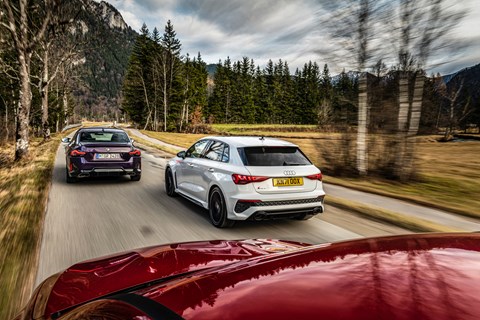
At 1690kg, the M model weighs substantially more than the Mercedes-AMG and the Audi. But the BMW also sports the longest wheelbase, eclipsing the RS3 by a significant 110mm. No surprise, then, that this 2-series – in essence a downscaled 4-series, remember – rides better than the competition, and thanks to the adaptive M suspension (fitted as standard in the UK) you can choose between a marginally cushier or firmer set-up. Although over 900kg of the kerbweight rests on the car’s nose, the chassis has homogeneity written all over its hard- and software.
A congenial support act, the xDrive system has been trained to push or pull, with tapering fingers or a bargepole, depending on driving style, speed, radius, steering angle and distance to apex. Especially with the DSC off, this sweet handling balance stems from the genetic code and is not the result of a chip-induced afterthought. Whatever’s around the next bend, the BMW is ready.
What if you’re in search of drifting ability? Lascivious hip swings call for concise choreography and a generous rehearsal space – like a racetrack with plenty of run-off area or an empty supermarket car park – and time to explore the host of different set-ups. In the Mercedes, Drift mode is accessed via a combination of shift paddle, ESP Off and the controller on the steering wheel. In the Audi, the most extreme option, labelled Torque Rear, turns the RS3 into a three-wheeled driving machine. In both cars, oversteer is achieved by channelling an extra-large portion of grunt to the outer rear wheel. This enables a wide selection of gymnastics from subtle and brief tailslides to full circles of varying diameter. The only constant is the deep black signature colour.
While the RS3 and the A45 had to develop fancy rear multi-plate clutches to conceal their front-wheel-drive roots, the BMW was born with a tail-happy torque distribution. Even in xDrive form, the system’s preferred torque recipient is always the rear axle, and this demeanour can of course be further emboldened by selecting M Sport or DSC Off.
But of course not every day is a drift day. And part of the GTI tradition – however loosely these cars may be tied to that heritage – is that they should be reasonably comfortable and practical and welcoming to bags and passengers. The Audi wins the Golden Eiderdown Trophy for the best ride in Comfort mode. The BMW is a close second, the Mercedes a distant third. For some, this cosseting means the car from Ingolstadt is the perfect 24/7 Jack of all trades. But you might feel that Comfort permits a little too much roll, pitch and yaw on uneven surfaces than is ideal in an RS model.
The M240i has no rear doors, making access to the modestly sized rear seats a bit of a struggle. But it also has an adequately roomy boot, at 390 litres, compared to the Audi’s 282 litres (or 1104 with the rear seats folded) and the A45’s 370/1210. The 2-series also stands out in this company by having a sportier driving position. It’s not so much the vehicle height but the lower seat which creates that coveted feeling of being in full control at all times.
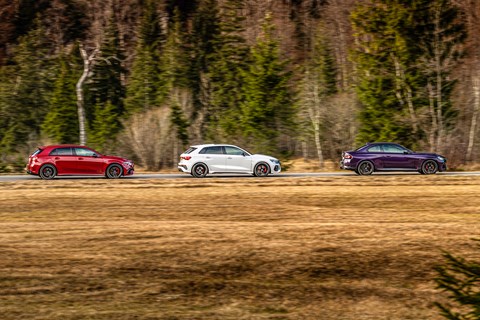
The BMW cockpit layout is relatively user-friendly, with a manageable number of haptic question marks, digital enigmas and functional mysteries. In contrast, the A45 S warrants a total-immersion course in advanced ergonomics. Its flat-bottomed steering wheel is studded with 15 different thumb challenges; the main monitor is happy to display and memorise special drills like drift angle, steering angle, g-force and throttle depression rate; the choice of go-faster modes includes M for manual, Race (with lap timer), Track Pace, Advanced, Sport Plus, Sport Handling and Powerful (exhaust note only). What’s missing are a couple of buttons to access the two preferred settings, BMW M1 and M2-style.
While the cabin of the AMG is gaudy and garish as well as loaded with features, and those five stylish eyeball vents, the dashboard of the Audi looks more e-Tron than RS, despite a handful of fire-red accents. The otherwise black driver environment is a sombre mix of matt and polished surfaces which attract fingerprints like moths to a flame. A few direct-consequence buttons lurk low down in the centre stack, but the main interfaces are a large touchscreen and the excellent voice control system. RS Performance mode preconditions the car for the next workout, while the newly introduced Runway instrument graphics boast gimmicks like g-meter, power and torque meter, digital speedo and two parallel bar graph revcounters. What a contrast with 2011’s first no-handbook-required RS3…
Each car is a fine expression of its maker’s art. With the AMG, you’ll be amazed what a wizard four-cylinder engine can achieve, even if you also find yourself regretting that so much commotion is involved. The Audi is incredibly quick and highly practical. And the BMW is a fine junior M4 – but is it even really competing with the more powerful, more expensive Audi and Merc? This will be an interesting verdict to write – and one you wouldn’t guess simply from looking at the spec sheet.
Second opinion: James Taylor, deputy features editor
I drove the UK-plated RS3 car back to the UK from Germany and was impressed by what a practical, stable, rapid, and very comfortable companion it made for the journey. Really the only fly in the car’s otherwise very agreeable ointment is the occasionally shunty twin-clutch ‘box. Maybe Munich is right, after all – certainly the M240i’s torque converter is both snappy to shift and creamy smooth when you’re in city traffic. Got places to go? The Audi is a motorway monster – on-tap power, decent fast-lane presence, nice ride, relatively quiet cabin.
The AMG makes a bigger song and dance about going quickly than the others, crackling its exhausts and tapping out a rhythm with its really quite hard suspension. Subjectively, it feels the quickest of the three, and provides the most exciting and breathless driving experience. The flip-side is that it’s harder to live with all the time; it can be OTT. As can its interior: so much information, so many controls, so much going on, all the time – but the most memorable of the three. Just like the driving experience.’
M240i vs RS3 vs A45S: the final reckoning
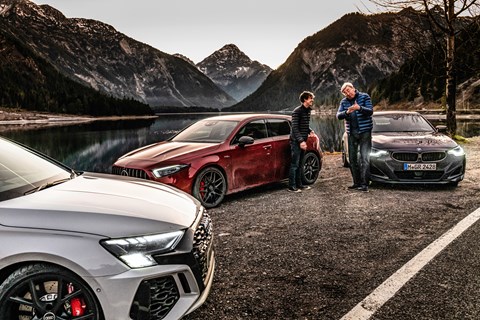
While the Audi and Mercedes were busy kicking each other’s heads in over our long weekend of testing, the BMW got promoted step by step, driver by driver. And it did so because the supposed class benchmarks lost some of their lustre between the glossy brochure and the reality of the winding road.
The M240i won in two areas of crucial importance for a roadgoing performance car: ride and handling. The steering is on another level, blending a fluent meatiness with total clarity and exactly the right measure of response. No comments added, no facts suppressed, no cryptic messages or fancy stunts clouding the performance. There is a linearity and honesty to this direction-finder the other two more heavily chip-loaded systems simply cannot match. Everything about it is spot-on: gearing, weight, balance, accuracy, speed of response, even the turning circle.
As an all-rounder, the Audi almost matches the BMW. It costs more but it also is quantifiably more rapid and it is thoroughly practical. But the potent engine does not make all the right noises, the cabin neither looks or feels particularly special, and the sensational brakes are no compensation for the split-personality suspension and the underwhelming steering.
The A45 S is a huge leap from the base A-Class. The highly tuned four-cylinder engine lives on a razor’s edge, audibly, physically and emotionally. Steering and brakes come out of the same weaponry. If you want a car for crazy 4am blasts, this is it. But if you ever drive in rush-hour traffic, and if you care about how your passengers are feeling, forget it.
So the BMW wins, by balancing all the qualities that matter. True, it ain’t pretty when viewed from certain angles, and it’s less lavishly appointed than its opponents. But on aggregate, when all the hard, soft and subjective points are added and weighed up, the M240i xDrive makes the most compelling compromise between a broad smile on your face and a not totally depleted bank account. It is neither the fastest nor the flashiest choice here, but as a totally honest driving machine with a rich pedigree it needs zero artificial preservatives to provide the full authentic flavour.
M240i vs RS3 vs A45S: verdict

First place
BMW M240i
Brilliant ride and handling with glorious usable performance; an M4 for those who don’t need full-size rear seats
Second place
Audi RS3
Very quick, quite practical, and offering the most comfort of this group. Let down by its handling
Third place
Mercedes-AMG A45S
Remarkable to think that deep down this is an A-Class, but its always-on edginess narrows its appeal
Read more CAR comparison tests